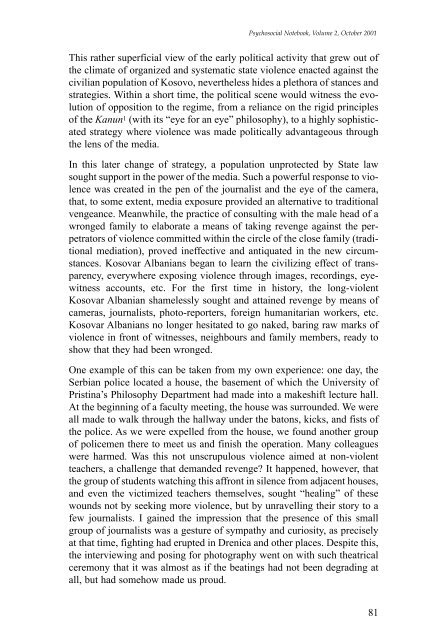Psychosocial Notebook - IOM Publications - International ...
Psychosocial Notebook - IOM Publications - International ...
Psychosocial Notebook - IOM Publications - International ...
You also want an ePaper? Increase the reach of your titles
YUMPU automatically turns print PDFs into web optimized ePapers that Google loves.
<strong>Psychosocial</strong> <strong>Notebook</strong>, Volume 2, October 2001<br />
This rather superficial view of the early political activity that grew out of<br />
the climate of organized and systematic state violence enacted against the<br />
civilian population of Kosovo, nevertheless hides a plethora of stances and<br />
strategies. Within a short time, the political scene would witness the evolution<br />
of opposition to the regime, from a reliance on the rigid principles<br />
of the Kanun 1 (with its “eye for an eye” philosophy), to a highly sophisticated<br />
strategy where violence was made politically advantageous through<br />
the lens of the media.<br />
In this later change of strategy, a population unprotected by State law<br />
sought support in the power of the media. Such a powerful response to violence<br />
was created in the pen of the journalist and the eye of the camera,<br />
that, to some extent, media exposure provided an alternative to traditional<br />
vengeance. Meanwhile, the practice of consulting with the male head of a<br />
wronged family to elaborate a means of taking revenge against the perpetrators<br />
of violence committed within the circle of the close family (traditional<br />
mediation), proved ineffective and antiquated in the new circumstances.<br />
Kosovar Albanians began to learn the civilizing effect of transparency,<br />
everywhere exposing violence through images, recordings, eyewitness<br />
accounts, etc. For the first time in history, the long-violent<br />
Kosovar Albanian shamelessly sought and attained revenge by means of<br />
cameras, journalists, photo-reporters, foreign humanitarian workers, etc.<br />
Kosovar Albanians no longer hesitated to go naked, baring raw marks of<br />
violence in front of witnesses, neighbours and family members, ready to<br />
show that they had been wronged.<br />
One example of this can be taken from my own experience: one day, the<br />
Serbian police located a house, the basement of which the University of<br />
Pristina’s Philosophy Department had made into a makeshift lecture hall.<br />
At the beginning of a faculty meeting, the house was surrounded. We were<br />
all made to walk through the hallway under the batons, kicks, and fists of<br />
the police. As we were expelled from the house, we found another group<br />
of policemen there to meet us and finish the operation. Many colleagues<br />
were harmed. Was this not unscrupulous violence aimed at non-violent<br />
teachers, a challenge that demanded revenge? It happened, however, that<br />
the group of students watching this affront in silence from adjacent houses,<br />
and even the victimized teachers themselves, sought “healing” of these<br />
wounds not by seeking more violence, but by unravelling their story to a<br />
few journalists. I gained the impression that the presence of this small<br />
group of journalists was a gesture of sympathy and curiosity, as precisely<br />
at that time, fighting had erupted in Drenica and other places. Despite this,<br />
the interviewing and posing for photography went on with such theatrical<br />
ceremony that it was almost as if the beatings had not been degrading at<br />
all, but had somehow made us proud.<br />
81

















